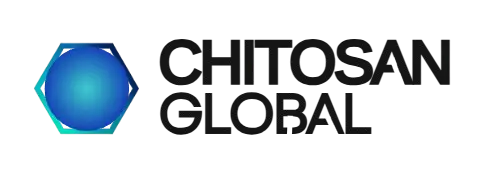
What is Mushroom Chitosan?
Mushroom chitosan is a natural biopolymer extracted from the cell walls of fungi. It’s derived from chitin, a structural component that gives mushrooms their rigidity and form.
Origin and Abundance
- Chitin is the second most abundant natural polysaccharide in nature, after cellulose.
- Most fungi contain 5%-7% chitin in their cell walls.
- Chitin is also found in the exoskeletons of crustaceans (crabs, shrimp, lobsters) and insects.
Pronunciation Guide
- Chitin: Pronounced “KITE-in” (emphasis on “kite”)
- Deacetylation: Pronounced “dee-a-SETTLE-ay-shun” (emphasis on “dee”)
- Acetyl: Pronounced “A-see-tl” (emphasis on “see”)
Chemical Structure and Properties
Chitosan is obtained through a process called deacetylation of chitin. This involves:
- Removing acetyl groups (CH3OH) from the chitin molecule
- Creating a polymer with free amine groups (NH2)
This chemical transformation gives chitosan its positive charge, differentiating it from its parent compound, chitin.
- Solubility: Unlike chitin, chitosan is soluble in acidic to neutral solutions, making it more versatile for various applications. Our food grade mushroom chitosan oligosaccharide is soluble in water at any pH. It is bactericidal at pH 6.4 and below. To purchase wholesale, click HERE
- Biocompatibility and Biodegradability: Chitosan is known for its excellent biocompatibility and biodegradability. It’s non-toxic and can be broken down by natural biological processes.
Uses and Applications:
Chitosan, a versatile biopolymer derived from chitin, has found widespread applications across multiple industries due to its unique properties. This biodegradable and non-toxic compound offers a range of benefits in various sectors:
- Healthcare and Pharmaceuticals: Chitosan’s biocompatibility makes it invaluable in medical applications. It is used in wound healing products, drug delivery systems, and as a biomaterial in tissue engineering. Its ability to promote healing and control drug release has made it a popular choice in the pharmaceutical industry.
- Environmental Protection: In water treatment, chitosan’s capacity to bind with heavy metals and other contaminants makes it an effective agent for purification processes. This property has led to its use in both industrial and municipal water treatment facilities.
- Agriculture: Farmers and agronomists utilize chitosan as a natural biostimulant and elicitor. It enhances plant growth and boosts resistance against pathogens, contributing to more sustainable agricultural practices.
- Food Industry: Chitosan serves multiple purposes in food production and preservation. It acts as an antimicrobial food additive and can be used to create edible films or coatings that extend the shelf life of perishable products.
- Beverage Production: In the alcoholic beverage industry, chitosan is employed for clarification of wines, beers, and whiskeys, helping to improve their clarity and stability.
- Dietary Supplements: The compound is also used in the production of dietary supplements, capitalizing on its potential health benefits.
- Plastics Industry: Chitosan’s biodegradable nature makes it an attractive option for developing eco-friendly plastic alternatives.

The wide-ranging applications of chitosan stem from its unique combination of biocompatibility, biodegradability, non-toxicity and positive electrical charge.
Variants:
- Traditional Chitosan: Traditionally sourced from marine crustaceans.
- Mushroom Chitosan: Derived from fungal sources, offering an alternative for those seeking non-animal-derived products.
Chitosan’s versatility, biodegradability, and non-toxic nature make it a valuable material across various industries, from healthcare to cosmetics. Its ability to be derived from non-animal sources also makes it an appealing option for vegetarian and vegan-friendly products.
What are the advantages of Mushroom Chitosan?
Mushroom Chitosan is a type of chitosan derived from the cell walls of fungi. It has several advantages over traditional chitosan derived from shellfish, including:
- 1. Vegan and vegetarian-friendly: Mushroom chitosan is an excellent alternative for individuals who avoid animal-based products, such as those who follow a vegan lifestyle.
- 2. Allergen-free: Traditional chitosan is derived from shellfish, which can cause allergic reactions in some people. Mushroom chitosan does not contain any shellfish-derived ingredients, making it an allergen-free option.
- 3. Purer: Mushroom chitosan is often considered to be purer than traditional chitosan because it is derived from a single source, whereas traditional chitosan can be contaminated with other shellfish-related substances.
- 4. Better solubility: Mushroom chitosan is more soluble than traditional chitosan, which makes it easier to incorporate into a variety of applications such as cosmetics, bioplastics, wound care and food.
- 5. Improved bioavailability: Some studies have suggested that mushroom chitosan has higher bioavailability compared to traditional chitosan, which means that it can be absorbed and utilized more effectively by the body.

Mushroom chitosan offers several advantages over traditional chitosan, making it an attractive alternative for individuals and industries looking for a vegan, allergen-free, and more effective chitosan source.
What are the benefits of chitosan in hair care?
Chitosan is a natural biopolymer derived from the structural elements in the cell walls of fungi, making it a vegetarian alternative to traditional chitosan, which is sourced from shellfish.
Chitosan and hair are complementary because they carry opposite electrical charges – Chitosan positive and hair negative . A Clear solution that contains chitosan forms a clear, elastic film on hair, increasing its softness and mechanical strength. The material can also form a gel when added to mixtures of alcohol and water.
Chitosan acts as an antistatic thereby protecting hair from waving and bleaching agents. It helps to retain moisture in low humidity and to maintain hair’s style in high humidity. The material can be used in shampoos , rinses, permanent wave agents, hair colourants, styling lotions, hair sprays and hair tonics.
In hair care products, mushroom chitosan offers several benefits and functions, and its efficacy will depend on the dosage used.

Benefits of Mushroom Chitosan in Hair Care:
- Moisture Retention: Chitosan has excellent moisture-binding properties, helping to keep hair hydrated and reducing dryness.

- Film Forming: It forms a breathable film over hair strands, offering protection against environmental stressors like pollution and UV rays.

- Hair Strength and Elasticity: By reinforcing the hair cuticle, vegetal chitosan can improve hair strength and elasticity, making hair more resistant to breakage.

- Frizz Control and Detangling: Its film-forming properties can help in controlling frizz and making detangling easier, leading to smoother and more manageable hair.

- Scalp Health: Possessing antimicrobial properties, it can contribute to a healthier scalp environment, potentially reducing issues like dandruff.

- Shine and Lustre: It can enhance the shine and lustre of hair, giving it a healthier and more vibrant appearance.

4. What are the functions of chitosan in hair care?
Functions in Hair Care Formulations:
- Thickening Agent: Chitosan can act as a natural thickener in shampoos and conditioners, improving texture and consistency.

- Active Ingredient Carrier: Chitosan’s film-forming ability makes it an effective carrier for other active ingredients in hair care products. It enhances their delivery, efficacy and provides sometimes considerable cost savings. This property allows for a more targeted application of beneficial compounds, ensuring they adhere to the hair and scalp for optimal results.

- Conditioning Agent: It contributes to the overall conditioning effect, making hair feel softer and smoother.

- Styling Product Component: In styling products, it can provide hold and shape to hair without the stiffness associated with synthetic polymers.

What are the recommended dosages of chitosan in hair care formulations?
The optimal dosage of mushroom chitosan in hair care products is tailored to achieve specific effects and complement various formulations. Generally, concentrations range from 0.1% to 2%, with lower amounts (0.1% to 1%) typically used in everyday products like shampoos and conditioners. For more intensive treatments or styling products aiming for enhanced film-forming and strengthening properties, higher concentrations of up to 2% may be employed. This flexibility in dosage allows manufacturers to fine-tune the chitosan content to maximize its benefits, whether for basic hair maintenance or more targeted hair care solutions. The precise amount used depends on factors such as the product type, intended effects, and interaction with other ingredients in the formulation.

Formulating with Chitosan
Chitosan in hair care applications
Non-shellfish-derived chitosan is emerging as a versatile ingredient in hair care, prized for its moisture-binding properties, frizz-reducing capabilities, and ability to enhance hair shine. As a natural film-former, it provides protective and strengthening benefits to hair strands.
Typically incorporated at concentrations of 0.1% to 2% in product formulations, chitosan’s effectiveness can be tailored to specific hair care needs.
Its eco-friendly profile, stemming from its natural origin and biodegradability, aligns well with the growing demand for sustainable beauty solutions.

Book a Free Consultation
If you don’t know what type of chitosan is best for your situation, Book an appointment. we will offer you an initial 30-minute consultation and product quotation at no charge.

